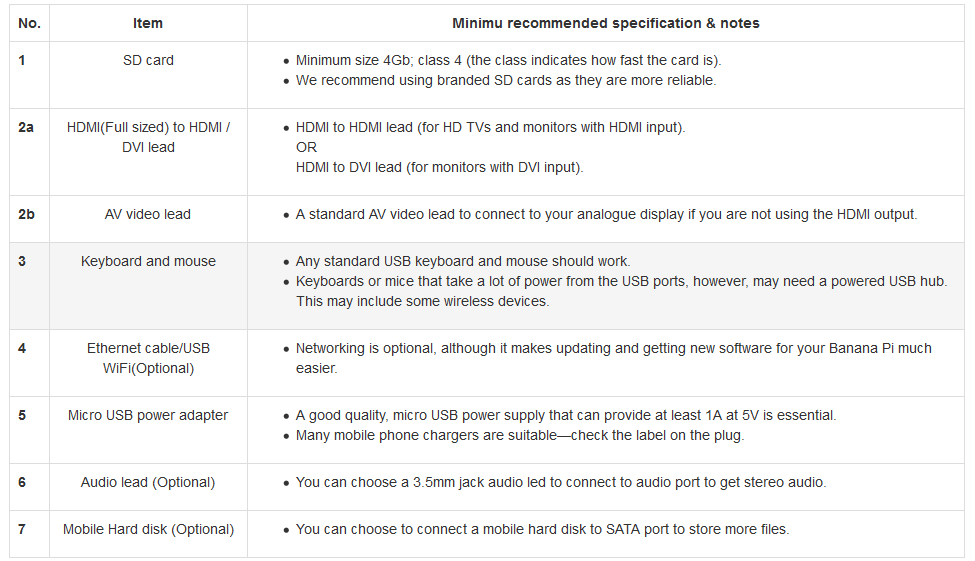Difference between revisions of "Banana Pi"
| Line 52: | Line 52: | ||
== Quick Start Guide == | == Quick Start Guide == | ||
| − | '''Step 1: Get what you need.''' | + | ''''''Step 1: Get what you need.'''''' |
First time to enjoy your Banana Pi, you need at least the accessories in the table below. | First time to enjoy your Banana Pi, you need at least the accessories in the table below. | ||
| + | [[File:step 2.jpg]] | ||
| + | |||
| + | ''''''Step 2: Prepare your SD card for the Banana Pi'''''' | ||
| + | |||
| + | In order to enjoy your Banana Pi, you will need to install an Operating System (OS) onto an SD card. Instructions below will teach you how to write an OS image to your SD card under Windows and Linux. | ||
| + | |||
| + | 1. Insert your SD card into your computer. The size of SD should be larger than the OS image size, generally 4GB or greater. | ||
| + | 2. Format the SD card. | ||
| + | '''Windows:''' | ||
| + | i. Download the a SD card format tool such as SD Formatter from | ||
| + | https://www.sdcard.org/downloads/formatter_4/eula_windows/ | ||
| + | ii. Unzip the download file and run the setup.exe to install the tool on your machine. | ||
| + | iii.In the "Options" menu, set "FORMAT TYPE" option to QUICK, "FORMAT SIZE ADJUSTMENT" option to "ON". | ||
| + | iv. Check that the SD card you inserted matches the one selected by the Tool. | ||
| + | v. Click the “Format” button. | ||
Revision as of 08:40, 9 April 2014
Description
It’s an open-source single-board computer. It can run Android 4.4, Ubuntu, Debian, Rasberry Pi Image, as well as the Cubieboard Image. It uses the AllWinner A20 SoC, and has 1GB DDR3 SDRAM. Banana Pi is for anyone who wants to start creating with technology – not just consuming it. It's a simple, fun, useful tool that you can use to start taking control of the world around you.
Hardware specification
CPU: A20 ARM® Cortex™-A7 Dual-Core
GPU: ARM Mali400MP2 Complies with OpenGL ES 2.0/1.1
Memory (SDRAM): 1GB DDR3 (shared with GPU)
Onboard Storage: SD (Max. 64GB) / MMC card slot UP to 2T on SATA disk
Onboard Network: 10/100/1000 Ethernet RJ45 (optional USB WIFI Dongle)
Camera Input: A CSI input connector allows for the connection of a designed camera module
Sound Input: Mic
Video Outputs: HDMI, CVBS , LVDS/RGB
Audio Output: 3.5 mm Jack and HDMI
Power Source: 5 volt via MicroUSB(DC In Only) and/or MicroUSB (OTG)
USB 2.0 Ports: 2 (direct from Allwinner A20 chip)
Buttons: Reset button: Next to MicroUSB connector
Power button: Next to Reset button
UBoot button (optional): Behind HDMI connector
GPIO(2X13) pin:GPIO,UART,I2C bus,SPI bus with two chip selects,
CAN bus,ADC,PWM,+3.3v,+5v,ground.
LED: Power Status LED (Red)
Ethernet Status LED (Blue)
User Define LED (Green)
Remote:IR
Supported OS : Android/Android 4.4/Debian/Ubuntu/Raspberry Pi
Product size : 92 mm × 60mm
Quick Start Guide
'Step 1: Get what you need.'
First time to enjoy your Banana Pi, you need at least the accessories in the table below.

'Step 2: Prepare your SD card for the Banana Pi'
In order to enjoy your Banana Pi, you will need to install an Operating System (OS) onto an SD card. Instructions below will teach you how to write an OS image to your SD card under Windows and Linux.
1. Insert your SD card into your computer. The size of SD should be larger than the OS image size, generally 4GB or greater.
2. Format the SD card.
Windows:
i. Download the a SD card format tool such as SD Formatter from
https://www.sdcard.org/downloads/formatter_4/eula_windows/
ii. Unzip the download file and run the setup.exe to install the tool on your machine.
iii.In the "Options" menu, set "FORMAT TYPE" option to QUICK, "FORMAT SIZE ADJUSTMENT" option to "ON".
iv. Check that the SD card you inserted matches the one selected by the Tool.
v. Click the “Format” button.
